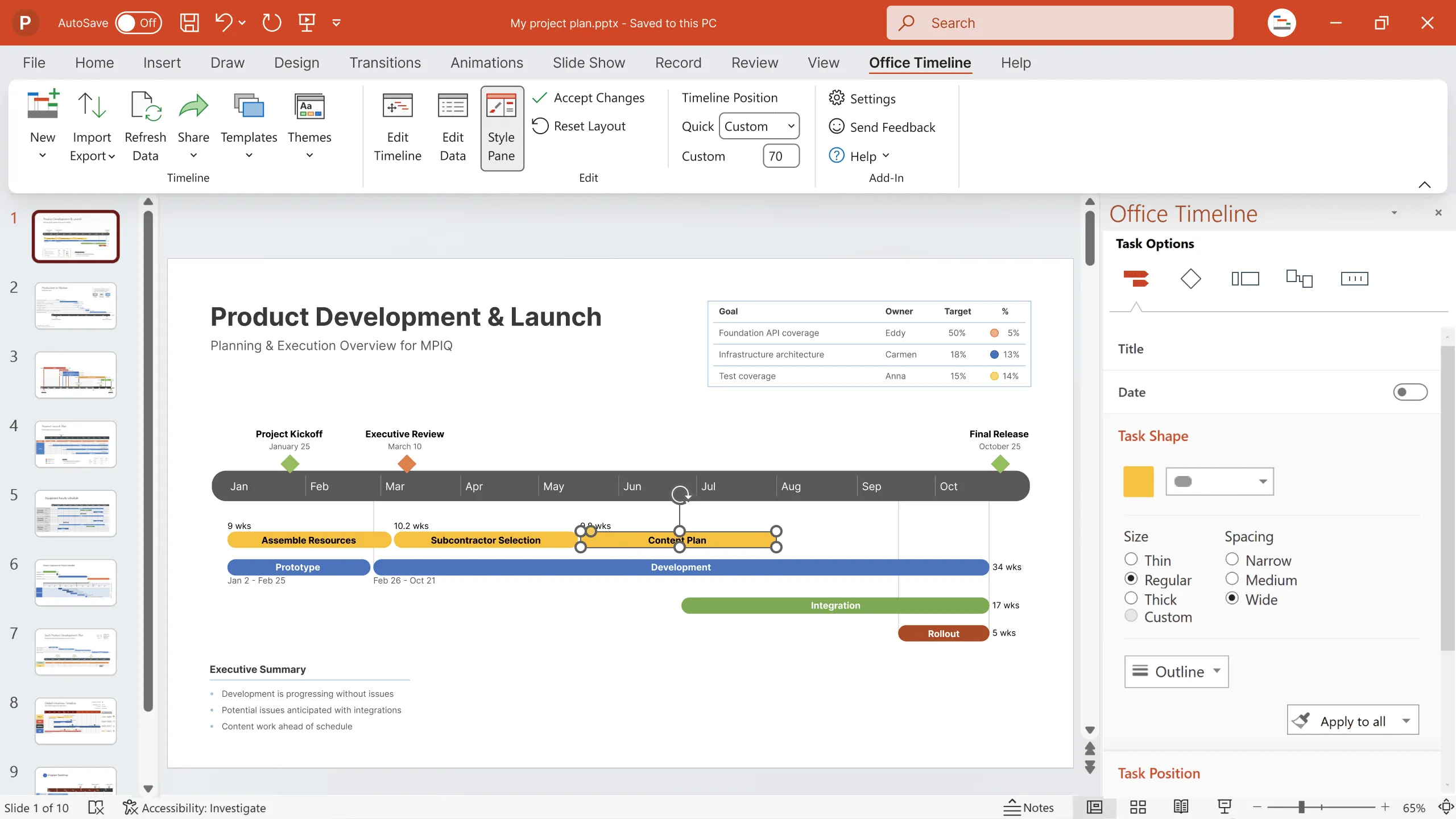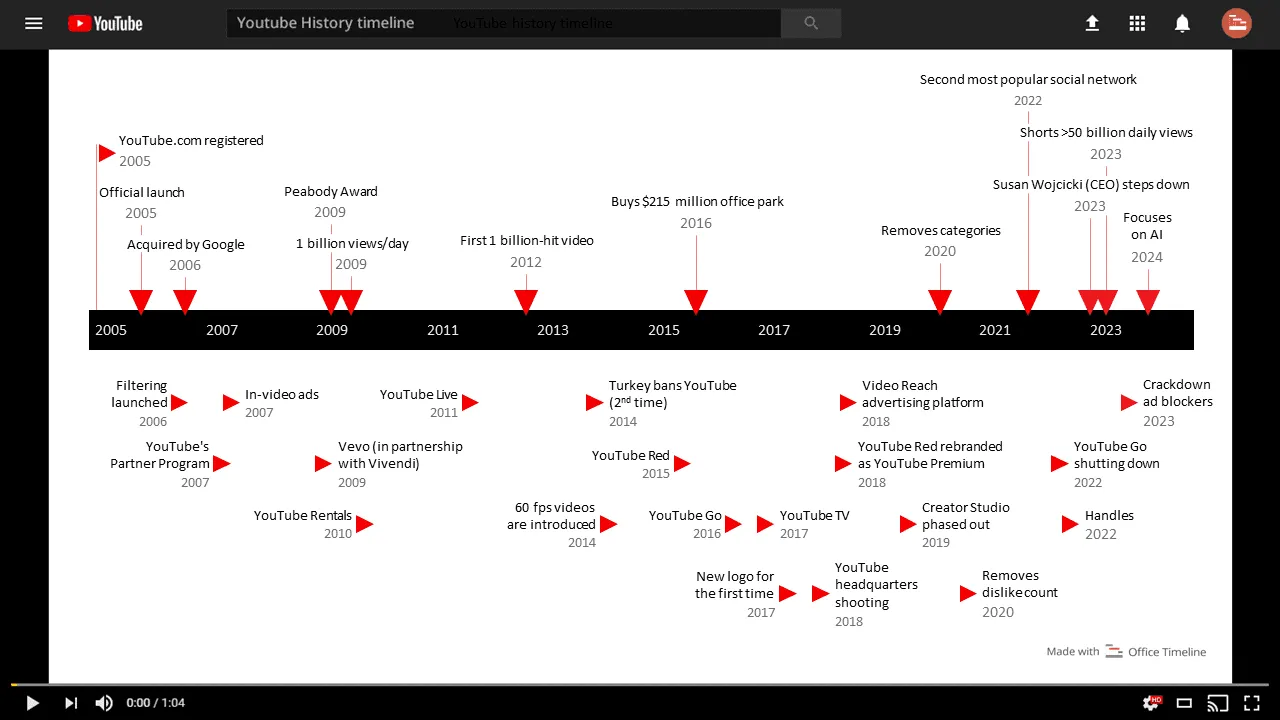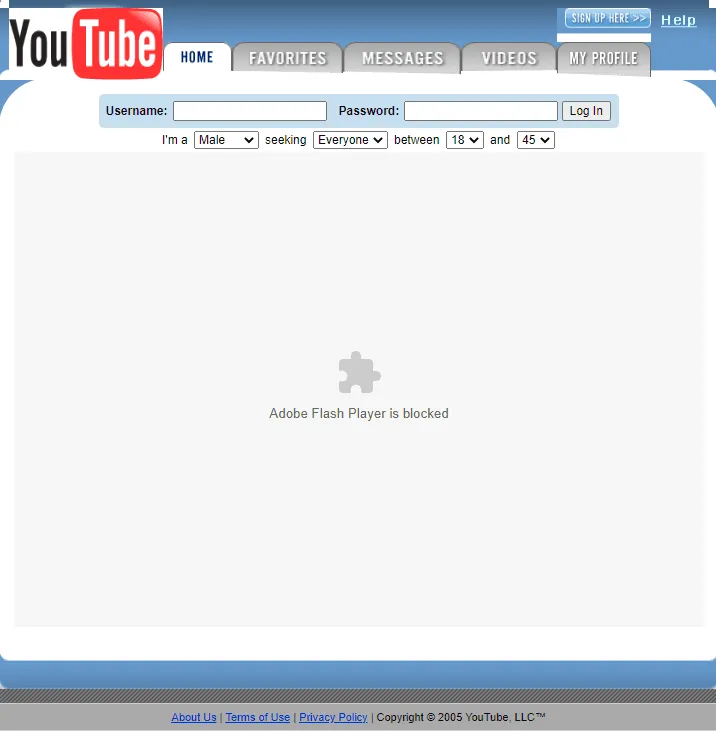History of YouTube: a timeline
Discover a visual history of YouTube with this free timeline from Office Timeline.
Updated on May 30, 2024
Set up in 2005 by three former PayPal employees and originally intended to be a dating service, YouTube is now the world’s most popular online video-sharing platform. With 1 billion hours of video watched every day and 500 hours of video uploaded every minute, YouTube has evolved from a site dedicated to amateur footage to a service that distributes original content.
To pay homage to this influential source of entertainment (and endless procrastination in many cases), we’ve created this blog post along with the YouTube Timeline, which illustrates the company’s evolution since its launch, outlining some of the most memorable moments throughout the history of this video content giant.
Apart from being everyone’s go-to video-streaming channel, it boasts other merits as well:
- Played a key role during the Arab Spring.
- Helped jump-start the careers of artists like Justin Bieber and Korean pop sensation Psy.
- Received a Peabody Award in 2008 and was cited as a "’Speakers’ Corner’ that both embodies and promotes democracy.”
YouTube timeline of events
- 2005: Registration of YouTube trademark, logo and domain on Valentine’s Day
- April 24, 2005: First video posted to the site (18 seconds long)
- 2005: Launch of its beta site in May, 2005
- September 2005: Reaching its first one million-hit video
- December 15, 2005: Officially launching out of beta
- June 2006: Deal with NBC ushering new digital era for the traditional media company
- October 2006: Acquisition by Google
- May 2007: Launching its Partner Program
- 2009: Earning even more widespread recognition
- April 2011: Launching YouTube Live
- December 2012: Reaching its first one billion-hit video
- March 2013: YouTube reaches 1 billion unique monthly visitors
- November 2014: Subscription service Music Key is added to the site
- November 2015: Launch of YouTube Red
- September 2016: YouTube Go is launched
- April 2018: YouTube headquarters shooting
- May 2018: Rebranding of YouTube Red as YouTube Premium
- November 2018: Starts ad pod testing on YouTube
- September 2019: YouTube unveils Video Reach platform
- June 2020: YouTube begins to phase out the use of categories
- December 2021: Removes dislike count
- January 2022: YouTube is ranked as the second most popular social network worldwide
- August 2022: YouTube Go is going away
- 2022: Introducing handles
- 2023: YouTube Premium ~26.7 million users
- 2023: YouTube Shorts > 50 billion daily views
- 2023: Crackdown on ad blockers
- February 16, 2023: Susan Wojcicki stepped down as CEO
- 2024: YouTube focuses on AI, top creators, subscriptions and community safety
Detailed YouTube timeline of events
Let's take an in-depth look at the significant events and milestones that have shaped YouTube over the years.
- Registration of YouTube trademark, logo and domain on Valentine’s Day, 2005
A year before YouTube’s official launch, former PayPal employees Chad Hurley, Steve Chen and Jawed Karim came up with the idea while attending a dinner party in San Francisco. As Karim declared in a 2006 interview, the propelling factor resided in the difficulty of finding online videos of Janet Jackson’s wardrobe malfunction at the 2004’s Super Bowl and of that winter’s devastating tsunami.
- April 24, 2005: First video posted to the site (18 seconds long)
Considering the type of broadcasts that are regularly going viral on YouTube, one might think the first video ever posted on the website must have been something insane. Well, it’s actually a very short clip of co-founder Jawed Karim standing near some elephants at the zoo and describing their “really, really long trunks.” The video is appropriately titled “Me at the Zoo” and has since been viewed more than 45 million times.
- Launch of its beta site in May, 2005
To understand the long way YouTube has come since this event, here’s a preview of the website’s initial homepage.
- September 2005: Reaching its first one million-hit video
The viral clip that helped YouTube score this record was a Nike ad showing Brazilian soccer player Ronaldinho receiving his pair of Golden Boots. This didn’t attract only the huge number of views, but Nike’s recognition of YouTube’s promotional potential as well.
- December 15, 2005: Officially launching out of beta
Thanks to the $3,5 million investment made by Sequoia Capital, YouTube was able to launch their site to the public by improving their servers and increasing their bandwidth.
- June 2006: Deal with NBC ushering new digital era for the traditional media company
In February 2006, NBC requested YouTube to withdraw one of the former’s broadcast SNL clips (”Lazy Sunday”), citing copyrights infringement. Not only did the video-sharing site comply, but it also launched its Content Verification Program, thus helping other content owners prevent similar situations from reoccurring (by locating and removing videos that infringe their copyrights). However, NBC later changed its tune and proposed that YouTube would promote its fall’s TV lineup. This deal paved the way for profitable partnerships with other content providers.
- October 2006: Acquisition by Google
Seeing the potential in what they called “the next step in the evolution of Internet”, Google acquired the rapidly growing video-sharing platform for $1,65 billion.
- May 2007: Launching its Partner Program
By taking this step, YouTube allowed everyday people get paid for their viral content. Thus, some users have succeeded in turning their hobbies into lucrative businesses, earning six-figure incomes from YouTube.
- 2009: Earning even more widespread recognition
With the 111th U.S. Congress launching its official Congressional YouTube channels in January 2009, many American citizens gained access to the government like never before, and YouTube became mainstream. The Vatican followed the lead and launched its own YouTube channel a month later.
- April 2011: Launching YouTube Live
By doing so, YouTube entered the broadcast business and started streaming a wide range of live content, from concerts and the royal wedding to news coverage and the Olympics.
- December 2012: Reaching its first one billion-hit video
The Korean pop artist’s video for ‘Gangnam Style’ brought in more than 1.3 billion views for YouTube, becoming its #1 most-watched clip (surpassed by “Despacito” with over 6.8 billion views as of June 2020). “Gangnam Style” had so many views that it “broke” YouTube. The view counter could not record numbers greater than a 32-bit integer, so it was updated to a 64-bit integer. That year was huge for the video-sharing platform for other reasons too, as it became the go-to place for the presidential election coverage in August 2012.
- March 2013: YouTube reaches 1 billion unique monthly visitors
At this point, nearly one out of every two people on the Internet visit the video-sharing website every month.
- November 2014: Subscription service Music Key is added to the site
This service enabled users to stream music videos advertisement free. Music Key replaced later (2015) by YouTube Red.
- November 2015: Launch of YouTube Red
This subscription service provides advertisement-free access to YouTube content. It became YouTube Premium in 2018.
- September 2016: YouTube Go is launched
Google announces the launch of YouTube Go, a new app targeting low-end devices, designed for offline viewing in countries where connectivity can be an issue. YouTube Go allows users to save videos for offline viewing.
- April 2018: YouTube headquarters shooting
On April 3, 2018, a shooting occurred at the YouTube headquarters in San Bruno, California. The shooter was later identified as 38-years-old Nasim Najafi Aghdam. She wounded three people, one of them critically, before killing herself. She was reportedly motivated by perceived discrimination by YouTube towards her channels.
- May 2018: Rebranding of YouTube Red as YouTube Premium
On May 17, 2018, YouTube announced the rebranding of the YouTube Red service as YouTube Premium. At the same time, YouTube announced the return of the YouTube Music subscription service in a new version.
- November 2018: Starts ad pod testing on YouTube
On November 21, 2018, Google announces they will start testing ad pods, that is, “two ads stacked back-to-back, where viewers have the option to skip directly to the content if it’s not the right ad for them.” Why? In their words, “when users see two ads in a break, they’re less likely to be interrupted by ads later”. The idea was to increase ad views and improve on monetization. The result? Barely anyone was happy about ad pods, viewers the least, and even a petition was filed.
- September 2019: YouTube unveils Video Reach platform
YouTube launches a new ad service, featuring AI for advertising campaigns. Its new Video Reach campaigns platform was unveiled at Advertising Week in New York and uses machine learning to determine most effective combination of ads. Advertisers will no longer focus on managing individual categories. Targets: better results, flexibility to choose ad formats, improved audience engagement and reach, and lower advertising costs.
- June 2020: YouTube begins to phase out the use of categories
The use of categories on YouTube starts losing relevance since they were created in times when algorithms weren’t as complex and intuitive as they are today. Back then, YouTube needed the users’ help to classify where their videos should appear. Now the algorithm takes care of categorizing videos and showing them to people who would be most likely to engage with the content.
- December 2021: Removes dislike count
YouTube removes the public dislike count on videos without removing the dislike button itself. While people can still dislike a video, the count displayed next to the dislike button is no longer be visible to the public. Only the video creator can see the number of dislikes.
- January 2022: YouTube is ranked as the second most popular social network worldwide
YouTube maintains dominance as a video social media platform. According to statista.com, YouTube ranks currently as the second most used platform, with 2.5 billion monthly active users (after Facebook – Meta, with 2.9 billion monthly users).
- August 2022: YouTube Go is going away
YouTube Go, an app providing offline video access, is set to be shutting down in August 2022. Since the main YouTube app has been greatly improved to offer a better experience in these markets, YouTube Go is no longer relevant, and it’s being discontinued.
- 2022: Handles are introduced
On October 10, 2022, YouTube announces “handles”[LC1] , that are unique identifiers aimed at helping people find and connect with channels. YouTubers get a specialized “Username-like” handle for their channels. Features:
Uniqueness: Each YouTube handle is unique, ensuring no two channels have the same handle.
Customization: Creators can choose their handles by visiting youtube.com/handle. If they don’t choose one by a specific date, YouTube will assign a handle based on their channel name.
Editability: Creators can edit their handles later if they wish to change them.
- February 16, 2023: Susan Wojcicki stepped down as CEO
Susan Wojcicki, YouTube's CEO for 9 years (since 2014), stepped down on February 16, 2023. She was with the company since 1999. She was succeeded by YouTube Chief Product Officer Neal Mohan.
- 2023: YouTube Premium ~26.7 million users
In 2023, YouTube Premium boasted around 26.7 million users, offering ad-free content. Initially introduced as Music Key in 2014 to provide uninterrupted music videos, it evolved into YouTube Red in 2015, then rebranded to YouTube Premium in 2018.
- 2023: YouTube Shorts > 50 billion daily views
In 2023, YouTube continued to focus on YouTube Shorts, its short-form, vertical video feature, surpassing 50 billion daily views. Creators increasingly used Shorts to attract long-form subscribers to their channels.
- 2023: Crackdown on ad blockers
In 2023, YouTube announced its crackdown on ad blockers globally. The platform warned users about violating terms of service by using ad blockers. In some case, YouTube restricted video playback unless users disable ad blockers or subscribe to YouTube Premium.
- 2024: YouTube focuses on AI, top creators, subscriptions and community safety
In 2024, YouTube's 4 main priorities include:
- Using AI creativity in Shorts and music,
- Supporting top creators,
- Growing subscription services like YouTube TV, Music and Premium,
- Keeping the community safe with improved content rules and technology.
FAQ about the history of YouTube
Find out the answers to the most frequently asked questions around the history of YouTube.
In 2005, three friends, ex-PayPal employees, named Jawed Karim, Chad Hurley, and Steve Chen came up with the idea of building a video sharing website when they couldn’t find online videos about events of huge popular interest, like Janet Jackson’s wardrobe malfunction at the 2004’s Super Bowl, or the devastating tsunami in the Indian Ocean. On February 14, 2005, they registered the YouTube.com domain. On April 23, 2005, Jawed Karim uploaded the first YouTube video, titled ‘Me at the Zoo,’ which was an 18-second clip, filmed at the San Diego Zoo.
Initially, YouTube was created on Valentine’s Day 2005 to be a video-dating website with the slogan ‘Tune In, Hook Up’. It was meant for users to share videos of themselves talking about the kind of partner they wanted. Thankfully, that didn’t work out! Thus, YouTube became a platform for anyone to post any video content they desired.
YouTube was created in February 2005, when three friends, Jawed Karim, Chad Hurley, and Steve Chen came up with the idea of building a video sharing website when they couldn’t find online videos about key events of interest at the time, like Janet Jackson’s wardrobe malfunction at the 2004’s Super Bowl, or the devastating tsunami of that winter. However, the original idea was to build a video-dating platform. Good thing that it didn’t work out! Then, YouTube’s founders realized the people were telling them what YouTube should be, not the other way around, turning YouTube into the video-sharing website that has changed the Internet.
YouTube was founded by Steve Chen, Chad Hurley, and Jawed Karim, friends and PayPal former employees. The founders of YouTube wanted to create an easy way for people to upload and share videos worldwide. In November 2006, Google bought YouTube.
It’s Jawed Karim, one of the three co-founders of YouTube, who posted the first-ever video on YouTube, titled ‘Me at the zoo’, an 18-second clip filmed at the San Diego Zoo. Posted on April 24, 2005, the video has over 240 million views.
YouTube is a video-sharing platform, based on user-generated content. Anyone can watch as many videos as they want without having to pay. You can make and share your own videos for free. YouTube is an individualized method of sending as much image and sound content as we can send electronically. And it does this in a way that is effective, easy-to-use, reliable, friendly and relatable. This is why YouTube became so popular and successful.
In September 2005, just months after the domain YouTube.com was registered (February 2005), YouTube got its first one million-hit video. The video was a Nike ad that went viral: Brazilian soccer player Ronaldinho receiving his pair of Golden Boots.
YouTube’s core strength is that it is a video platform where anyone can upload their user-generated content. Also, YouTube is popular is because it is free and easy to use. You can watch as many videos as you want without having to pay, and you can also make and share your own videos.
YouTube became pretty popular very quickly, with around 30,000 visitors per day shortly after the site opened on a limited basis (May 2005). Its success and popularity have been continuously increasing ever since. Here are some numbers:
- By December 2005, when YouTube was officially launched, it was serving more than two million video views each day.
- By January 2006 the number of views per day had increased to more than 25 million.
- In March 2006, the number of videos available at the site surpassed 25 million, and more than 20,000 new videos were uploaded on a daily basis.
- By the summer of 2006, YouTube was serving more than 100 million videos per day, and the number of videos being uploaded to the site continued to increase.
- In comparison, as of February 2020, more than 500 hours of video were uploaded to YouTube every minute (~30,000 hours of newly uploaded content per hour). Between 2014 and 2020, the number of video hours uploaded grew by about 40%.
The first person in the history of online video to reach 1 million subscribers is Fred Figglehorn, the chipmunk-voiced YouTuber and Internet star. In less than a year, he has passed every filmmaker, artist, cute dog and silly cat on YouTube.
On April 24, 2005, YouTube co-founder Jawed Karim posted the very first video to YouTube. It was an 18-second clip titled ”Me at the Zoo“, showing Karim at the San Diego Zoo standing in front of the elephants and discussing their trunks.
Currently, Google LLC owns YouTube.
YouTube, the American online video- sharing platform, was founded in February 2005 by three former PayPal employees (Chad Hurley, Steve Chen, and Jawed Karim) and was acquired by Google November 2006 for US$1.65 billion. It now operates as one of Google’s subsidiaries.
About the YouTube History Timeline
The YouTube chronology was created with the help of Office Timeline, a flexible PowerPoint add-in that allows users to quickly generate timelines, Gantt charts and other similar visuals for business or academic presentations.
To update the free timeline slide of the history of YouTube or easily build your own brand new timelines from templates or from scratch you'll need to download the free 14-day trial of Office Timeline.
Tim is Co-Founder & CEO of Office Timeline, a Seattle-based start-up that aims to rid the world of boring, uninspiring meetings.
Turn project data into professional timelines
Get the advanced features of Office Timeline free for 14 days.




